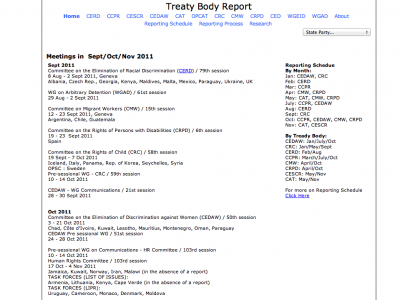There appears to be a growing awareness of intersex issues at the UN. The High Commissioner, Navi Pillay very recently mentioned intersex. Just a crumble still and a bit silly to have to cheer for that, but also: on this level things move (too) slowly. Sometimes the national level works fast, but sometime pressure form the UN or regional human rights bodies is needed.
September 2011 the first world intersex forum took place in Brussels under the auspices of ILGA and ILGA Europe. Intersex activists from all over the world gathered there to see how the issue human rights for intersex people could be raised, what is needed to This document is written not for the experts. It is intended to be used by activists and may be trivial to the experts. However their comments are quite welcome.
With the aim to use the United Nations Human Rights system for reporting intersex related human rights issues, it is necessary to know where to go, how to proceed and when to do that. This paper intends to give an overview of the most important mechanisms to use and examples where they have been used already.
UN Human rights bodies are either Charter based (on the charter of the UN) or treaty-based (specific treaties like CAT, CEDAW, CERD, CRC).
As far as states have ratified UN treaties, these are a good way to attract attention to intersex issues. The German intersex organization Intersexuelle Menschen e.V. for example has delivered already two shadow reports on intersex. In 2008 for CEDAW (the “Women’s Treaty”, Convention on the Elimination of Discrimination Against Women”) and in 2010 for the CESCR (Convention on Economic Social and Cultural (ESC) Rights). You can find them on their special website: http://intersex.shadowreport.org
Also from Germany there is a comment from the Committee of the treaty against Torture, that is on its way declaring IGM to be torture (not yet, not quite but still): CAT state report Germany 2009
Next to these another good candidate would be the CRC, Convention on the Rights of the Child. Complaints about Intersex Genital Mutilation that mostly take place during infancy or youth of the person, are an issue that can be taken up quite well here.
Apart from these treaties asking for shadow reports in their two- or four-yearly review process, there is the mechanism of the Special Procedures. Special Procedures are persons working as Special Rapporteurs,or a working group, typically existing of five people. Their work is on countries or on issues. The current Special Rapporteur for Violence against Women is Prof. Rashida Manjoo (RSA). Anand Grover (India) is the SR on Health Issues. He is known to be keen on transgender health, so most probably he will be sensitive to complaints on intersex as well. Former SR on Counter- Terrorism and Human Rights Martin Scheinin has spoken out on how counter terrorism measures may affect LGBTI persons especially (currently Ben Emmerson, UK takes this function). All Special Rapporteurs can be found on this OHCHR web page: http://www2.ohchr.org/english/bodies/chr/special/themes.htm
For those of us working on Europe and wanting to attract attention it might be good to gather some cases to go both to the ECtHR in Strasbourg whose verdicts are binding, and to go to the UN through complaints to Special Rapporteurs or through Optional Protocols to treaties (as long as the respective state made no reservation on the issue at hand).
Further documentation:
The referred to German reports:
Be aware of terminology however. Not only regarding “intersex” or “DSD” but also the definition used. Also: using the wrong search terms may leave you without results.
Specific information per UN Human Rights Body.
I provide links only, content (names and dates) may change and that is better left at the provider than local. This overview comes directly from the UN page on Human Rights bodies.
|
Charter-based bodies
|
|
Treaty-based bodies There are ten human rights treaty bodies that monitor implementation of the core international human rights treaties :
|
General information on the working of the treaty body system can be found at the site of the Office of the High Commissioner for Human Rights: The website Treaty body Report is a very useful resource also. There you can find historical and actual information on all relevant treaties, with search options per state party.
Several special rapporteurs already have engaged with intersex and the UN starts understanding bit by bit our needs. Only slowly. Some examples:
- In 1999 the SR on Extrajudicial Summary and Arbitrary Execution was the first to engage with sogi issues (not intersex yet): she included several cases of severe persecution of sexual minorities.
- The issue of LGBTI is also known to the SR on Human Rights Defenders since 2001 and the SR on Health Anand Grover is aware of trans and intersex issues.
Together they can be reached through the addresses you can find here at the OHCHR website. Efforts to make the UN appreciative of intersex issues are being noticed. Now to step up the efforts and tell the SRs and the treaty bodies what is going on.
The British Equality and Human Rights Commission – among others -has information on how to write a shadow report on their website. On LGBT and intersex human rights issues ARC International works together with COC Netherlands and Global Action for Trans* Equality (GATE) for higher activity at the UN bodies and attempts to coordinate sex, sexual orientation and gender identity and expression related issues (SSOGIE, better known in the reduced acronym SOGI) at the respective UN bodies as there is the Human RIghts Council or CEDAW.

